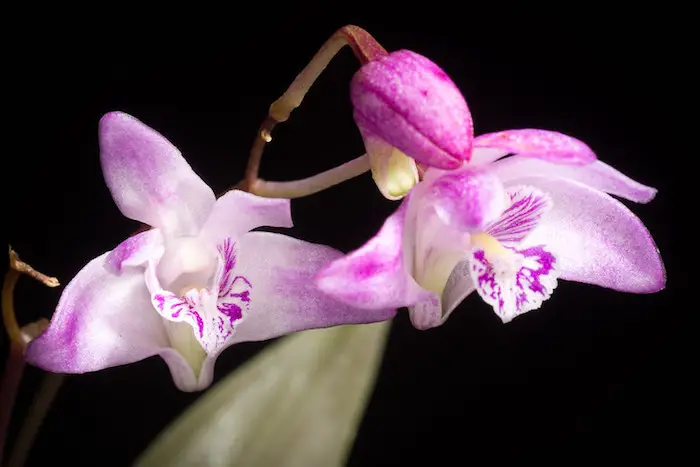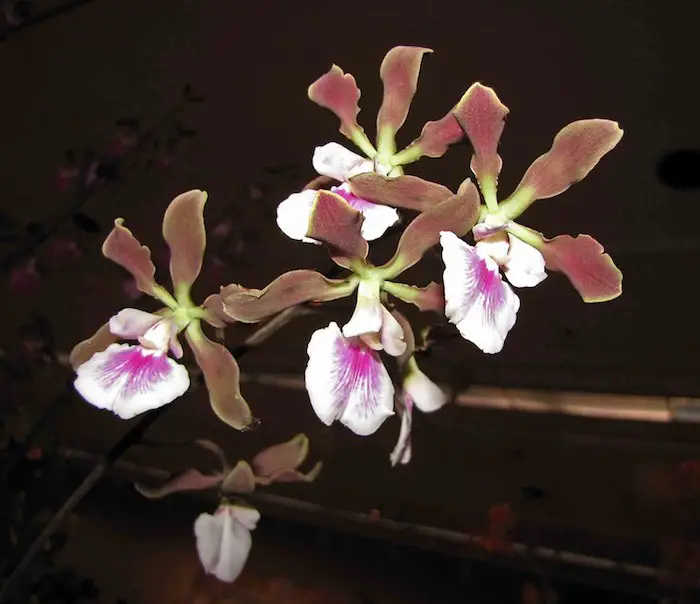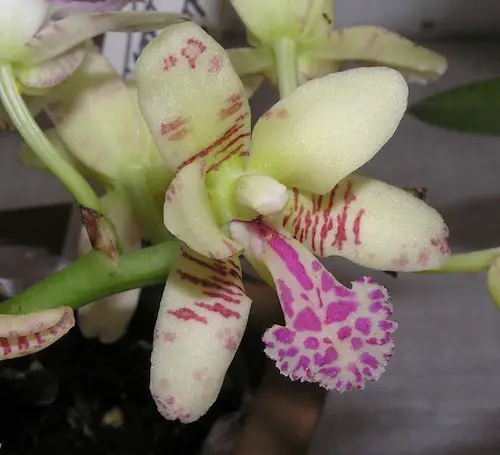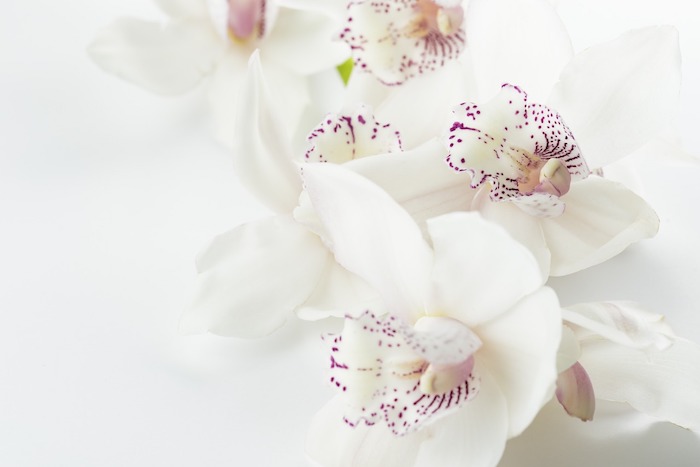Ultimate List Of Fragrant Orchids
Think of Orchids and the first thing that comes to the mind is visually appealing colors, aesthetically pleasing forms, and of course the fragrance. Do you know that the scent released by these flowers have a specific purpose and that is to attract pollinators like butterflies, bees, moths, hummingbirds, and flies.

Some varieties of orchids do not produce a strong fragrance as they attract pollinators through other ways such as shape, size, and visual color instead of scent. Some Orchids do not require pollinators but they still produce a foul odor similar to trash to attract flies and gnats.
Most of the large boxed orchids you can see in the grocery stores or supermarkets are visually appealing but they do not have a pleasant smell. They have enhanced flower size and blossoming time to attract the customers; however, they are not fragrant in the real sense.
If you want to get some truly fragrant orchids, you must gather some information about them and go to orchid nurseries or greenhouses. You may also get them online, but most importantly you must know which are the fragrant varieties. To make it easier, we have created an ultimate list of fragrant orchids. Let’s check them out.
#1. Aeranthes Grandalena
This hybrid variety was formed by cross-pollination of two fragrant parents Aeranthes grandifloras and Angraesum magdalenae. While Angraesum grandifloras smells like butterscotch or caramel; Aeranthes Magdalena’s fragrance is similar to the jasmine flower.
The child flower Aeranthes Grandalena is pale-white with a dash of green with darker leaves. It has subtle notes of jasmine with a hint of sweetness. They require light medium-warm temperature to thrice and emit fragrance both day and night.
#2. Cymbidium Sinense

Native to South-Eastern Asia, Cymbidium sinense can be found in Burma, Thailand, India, and China. As a potted plant, it reaches a height of 25-60 cm. They typically bloom 6-26 flowers in the New Year’s time and they have a pretty strong scent that is both fragrant and heavenly.
They are known as ‘hosairan’ in Japanese, which means orchids that tell New Year has arrived. They require shade and indirect light, more shade in summer and less in winter. Roots also need water and the humidity levels hould be maintained at 50-50% during winter season and higher in summer.
#3. Brassavola Nodosa

They are known as ‘Lady of the Night’ due to their strong resemblance with lily of the valley whose perfume is the strongest at night. The orchid is a cluster of small white flowers that release a pleasant bewitching perfume to attract white moth. We recommend having one of these indoors as the smell can be overpowering.
The Brassavola orchid is easy to grow and doesn’t require to be watered as much. They do well in hanging baskets or when mounted on the wall. They need warmer temperatures and bloom in summer.
#4. Cattleya Walkeriana

Cattleyas orchids are popular for their distinct scent that is more notable than the visually appealing and large-sized boxed orchids. Walkeriana belongs to Cattleyas family and features purplish-pink flowers that bloom in April and stay for a month or so. The scent is towards vanilla and cinnamon.
Also known as the Queen of the Brazilian Savannah, this Orchid variety is native to the region of the central plateau in Brazil. They require hot and dry weather with full sun and high temperatures, making them tricky to grow indoors.
#5. Cymbidium Golden Elf
This beautiful orchid with vibrant yellow hue blooms from spring to fall, late August to early in the month of September. The flowers emit a refreshing and nice light-citrus flavor that resembles a lemon, and you can feel the smell from far.
The plant thrives well in the proper light and tolerates hotter temperatures. As a grower, make sure you keep the potting medium moist for best results. If the pot is the right size then don’t worry about repotting as soon as the plant tends to be root bound.
#6. Cycnoches Wine Delight
The flower exhibits a deep red color like that of red wine, but do not smell like one. The fragrance is more like the spicier aromas – a blend of pepper, mint, and spice, with a hint of sugar. In the morning, you get a cherry fragrance that fades away during the day.
Each Cycnoches has about 7 to 10 flowers on each spike, and they prefer sunlight for some part of the day (preferably 16 hours). The leaves are yellowish-green and they love highly humid weather.
#7. Dendrobium Kingianum

The orchid is native to Australia, and flaunt a shade of pink magenta. They are known by so many different names such as Captain King’s dendrobium, Thelychiton kingianus, Pink rock orchid, and so on. It is often called the easiest plant ever as they require less maintenance.
The fragrance of these flowers is similar to sweet clover and hyacinth, with a hint of wildflower honey. Some people feel that they smell like medicine while others say they are like hyacinths. The potting medium needed woodchips and charcoal, and they thrive in desert-like conditions with high temperatures and less humidity.
#8. Encyclia Cordigera

Native to the Central America region, you can find these orchids throughout Panama and the tip of Brazil. The flower scent is similar to chocolate, vanilla, and honey. The aroma may vary from plant to plant. The plants require constant watering to grow and they thrive on high light conditions.
The pseudobulbs appear like small onions if watered properly. In full bloom, they stay open for almost a month. When the plant is grown in direct and full sunlight, the aroma will be more powerful and keep intensifying as the temperature increases.
#9. Maxillaria Tenuifolia

This plant with small leaves and massive leaves is a must-have for any orchid enthusiast. Even when the flowers do not bloom, the plant looks great indoors with pseudobulbs and long slender leaves. It has a lingering tropical smell that resembles Pina Colada or coconut, due to which it is often called The Coconut Orchid.
This orchid plant is native to Mexico, Belize, Guatemala, Nicaragua, and El Salvador. The flowers bloom around the month of March or April. As the plant thrives in a humid environment, we suggest adding sphagnum moss to the potting mix to ensure that the roots get enough moisture.
#10. Miltoniopsis Santanaei

These flowers are small like pansies, but the fragrance is like roses. In the past, they had a bad reputation for being difficult to grow. However, if you are able to provide their preferred low light conditions (900 to 1000 fc) and favorable high temperatures, they grow really well.
These orchids are native to Colombia, Brazil, and Ecuador, but they can grow at various locations with proper care. The Santanaei has a district fragrance like that of spices.
#11. Miltoniopsis Herr Alexander
The Militoniopsis are known for their fragrance akin to rhubarb pie, but Herr Alexander differs from the lot with a honey-scented flower. The scent is strongest from early noon to afternoon hours while the sun is at its peak. After that, you can still feel the fragrance but it’s not overpowering.
The plant prefers a humid and cool environment, and they are one of the few orchid plants that thrive well in sphagnum moss. The most challenging aspect of growing Miltoniopsis Herr Alexander is to ensure that the temperature indoors is as low as they prefer. They are native to Colombia and Peru, and bloom from mid-August to late September
#12. Neofinetia Falcata

Often referred to as the ‘Orchid of the Shoguns’, this houseplant orchid dates back to the 1600’s when they were popular in Asian countries like Japan, Korea, and China. As per the traditions, the Japanese Samurai carried these flowers as a harbinger of good fortune.
Falcata orchids (see Etsy) grow in lower-light conditions and they prefer a bright shade over direct sunlight. They have a subtle fragrance that blends jasmine scent with vanilla. Some people feel that the flowers emit a citrus coconut scent. We guess the scent may vary slightly based on light, temperature, and humidity.
#13. Oncidium Sharry Baby

This is one of the most popular fragrant orchids worldwide and they have a unique smell of chocolate, which some people describe as candy, vanilla, honey, milk chocolate, or vanilla chocolate. The flowers are deep purple with yellowish-brown speckles, and they grow in masses.
These plants can tolerate dry and bright light conditions, and they are perfect for mounting or hanging in baskets. We suggest that you use a medium grade bark and let the water dry out before watering again. If the pseudobulbs look healthy, it indicates that the plant does not need water and if they appear wrinkled, you need to water them. You can get it here
#14. Oncidium Twinkle Fantasy

The Oncidium Twinkle Fragrance Fantasy is a relatively new hybrid plant that was created in Hawaii by cross-pollinating two fragrant Oncidiums, resulting in Twinkle Fantasy. It has a strong flavor that can be compared to spicy vanilla with a hint of sweetness.
While these plants do not take too long to grow, the flowers take longer to blossom but all that wait and patience is well worth it. When the thousands of tiny flowers blooming, you can find about 20 flower spikes on any adult plant at a time. They don’t like the sun so they make good indoor plants.
#15. Oncidium Ornithorhynchum
Native to Colombia, Ecuador, and Peru, this variety of orchids is our favorite because the flowers are both visually appealing and highly fragrant. Their specialty lies in the fact that hundreds of flowers bloom at a time and they smell like cinnamon and vanilla filling up any room they are kept in.
In the morning, these flowers carry a much stronger smell that resembles wine or grape. As the sun starts fading, the fragrance changes to a more relaxed note, which is similar to baby powder with a hint of cinnamon. The pink angelic flowers look heavenly when used as couch centerpieces, displays, or plant stands.
#16. Phragmipedium Schlimii

David Eickhoff
If you are planning to grow orchids indoors, the Phragmipedium Schlimii is one of the best-scented ones with rose -almost-berry fragrance. They require a moist and humid environment like Cattleyas. If you want to fill a room with its smell, you will need to plant at least seven or eight of these plants
These plants prefer low light conditions ranging between 1000 fc and 1400 fc, and the ideal temperature should stay between 58ᵒF to 68ᵒF. We love that these flowers bloom all the year-round, except in winter. The pink, purple and yellow flowers can grow on rocks, pebbles, and stones. They can be found growing on river banks where the humidity levels are high.
#17. Phalaenopsis Violacea

If you are a beginner and want a fragrant flower plant that you will get hooked to then get the Phalaenopsis Violacea. You will not find this variety in the big boxes in the grocery stores or supermarkets, but the search for this plant will be well worth the trouble.
The small-sized attractive orchid plant with little purplish-red flowers emits a refreshing and spicy cinnamon flavor. Natively grown in the Philippines and Malaysia, their leaves are light green shade. The fragrance is similar to cinnamon blended with rosy-floral notes without being too overpowering.
#18. Rhynchostylis Gigantea

These fragrant orchids are a beautiful spectacle that awe beholders with their bushy flowers and fox-tail appearance. Native of Southeast Asia, Rhynchostylis gigantea (see Amazon) can be found in Myanmar, Vietnam, Laos, and Thailand where the climate is humid and warm. If growing indoors, you will need to maintain 2000 to 2500 fc light.
As these flowers prefer a humid environment, you will need to water them more often. They tend to grow 15 to 50 flowers on a single spike and the scent is similar to spicy citrus. You must ensure that there is enough ventilation in the room where you keep them to avoid an overpowering scent.
#19. Rhynchorides Bangkok Sunset

Bangkok Sunset is a hybrid plant resulting from a cross between Aerides houlletiana and Rhynchorides Thai Noi. The flowers may be yellow, white, orange, or pink, and the spikes are usually erect. They usually emit a moderate fragrance which is refreshing floral and clean. The fragrance is intense in the first part of the day and slowly fades away towards the evening and night.
#20. Sedirea Japonica

This is another popular orchids species that smells of fragrant species blended with the smell of fresh and delicious lemon pie. As the flower is already a little sweet, it is much enjoyable. When you smell the flowers, they remind you of lemon fruit.
#21. Vanilla Planifolia

This orchid may not be visually appealing but they are one of the most popular ones we know that dates back to the era of Aztecs. No points for guessing these flowers smell like vanilla, after all this is a vanilla plant. They are one of the most edible orchids that mostly grow outdoors. If you grow them indoors, you will need to recreate a favorable environment that is not very humid. You can get it on Amazon
The potting mix comprises part soil, bark and sphagnum to give it a perfect aerated environment that’s not too damp. Once they become trees, they can grow up to 20 to 30 feet high. The flowers are pale yellowish in color, not very attractive but pretty nevertheless. If you would like to get attractive vanilla orchids, we suggest you look for Vanilla Roscheri or Vanilla Phalaenopsis.
#22. Zygopetalum

Native to Argentina, Brazil, Bolivia, Zygopetalums, and Peru, there are about 15 different species of Zygopetalums and each has some sort of scent associated with it. The aroma may be like that of baby powder, hyacinths, or jasmine. Each variety has a strong or soft fragrance which is unique.
Zygopetalum has pseudobulbs, hence they are capable of storing water much better than other varieties. These plants can be easily grown indoors mounted on slabs or hanging in baskets. They prefer low humidity and bright indirect light for 14 to 16 hours a day.
#23. Cymbidium Goeringii
Native to South-Eastern Asia, Cymbidium sinense can be found in Burma, Thailand, India, and China. As a potted plant, it reaches a height of 25-60 cm. They typically bloom 6-26 flowers in the New Year’s time and they have a pretty strong scent that is both fragrant and heavenly.
They are known as ‘hosairan’ in Japanese, which means orchids that tell New Year has arrived. They require shade and indirect light, more shade in summer and less in winter. Roots also need water and the humidity levels hould be maintained at 50-50% during winter season and higher in summer. This is an evergreen orchid, a native of the cold regions of East Asia and mostly found in China and Japan. They feature round below ground pseudobulbs, grass-like leaves, and bright green flowers with purplish striations.
The emerald-green flowers carry a lingering fragrance similar to lily-of-the-valley and jasmine. They can even grow in rocky woods. They thrive in all seasons – cool temperature, low light and dry conditions in winter and warm temperature, bright light, and moist conditions in summer.
Tips To Ensure Fragrant Orchid Blooms Last Longer
Orchids typically bloom one to two times in a year and they may last for 60 to 120 days. A typical blooming season is usually from January to March. If you wish to keep the blooms for their optimum period, here are some tips that can help you:
- Remember to water your orchids as per the requirements. Some flowers need to stay hydrated but avoid overwatering as you don’t want the roots to rot.
- Many varieties require cool shade and they bloom in cold seasons make sure the temperature is nice and comfortable for the blooms. For these species, you can keep them longer by lowering the temperature of the area where they are kept.
- Keep the pollinating insects away from the orchid flowers. As soon as they come in contact with flying insects or bees, the flowers get pollinated and die soon after
- Avoid misting the blooms too often or keeping them in high humidity areas. Too much moisture may lead to different types of orchid diseases that affect the quality of blooms.
- Don’t keep blooms near any ripening fruits because when fruits ripen they emit ethylene gas that may cause the orchids to die out quickly.
- Don’t expose the blooms to direct sunlight as this can cause sunburn resulting in blooms dying out quickly. You must, however, ensure that they get adequate indirect light using sheer curtains
See Also: Are Orchids Poisonous (Human&Pets)
Related Questions
What’s the reason behind the different intensities of fragrances
Each variety of orchids may have a different type of fragrance and the intensity of the scent may vary at different times of the day. Some are mildly fragrant while others may be overwhelming and intoxicating. The flowers tend to be more fragrant when there’s more sunlight as this warms up the volatile oils for diffusion. The smell slowly fades away as the sun goes down.
What are the best fragrant orchids for beginners
If you are a beginner looking for fragrant orchids to grow, we suggest that you get an Oncidium or a Cattleya. Remember that not all orchids are fragrant, so stick your nose to feel the smell before making the payment. Avoid the supermarket boxes if you can and get them from the local nursery.
How many orchid fragrances are known to humans?
If we judge orchids based on fragrances alone, several considerations are taken into account, such as the intensity of the fragrance, the distance traveled by the scent, complexity, and overall appeal. The experienced and highly trained perfumers are able to identify more than 3,000 distinct odors.
See Also: How To Water Orchids In Moss

